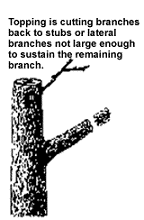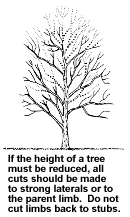Risks of “topping” trees
Tree topping is when the branches of a tree are cut off into stubs or lateral branches that are not able to hold the remaining branch. Most people do this because they think it is the best way to reduce the height of a tree. However, it actually does more damage to the tree than good, and can create even more of a hazard than an overgrown tree can. Topping is also referred to as “heading,” “tipping,” “hat-racking,” or “rounding over.”
There are many, many dangers associated with topping trees. Topping trees causes decay, puts stress on the tree, and can lead to “sunburn.” When a tree is pruned incorrectly, the cuts create large wounds that the tree is usually not be able to heal on its own. The wood tissues that are left exposed will then begin to decay, which occurs in each place that the tree is “topped.” Topping also adds stress to the tree because it removes at least half, if not all, of the leaf-bearing portion of the tree, which is where trees receive their food from. “Sunburning” of a tree also occurs when the leaves are suddenly removed and the remaining branches and trunk are instantly exposed to high levels of heat and light, which can be detrimental to the health of the tree.
Instead of topping a tree, the best thing to do is prune a branch back to its point of origin if you are trying to reduce the height of a tree. If the branches are what you are trying to shorten, they should be pruned back to a lateral that is still large enough to sustain the remaining portion of the branch. If you feel uncomfortable pruning a tree yourself, a professional arborist can be called, who is very knowledgeable and capable. Professional and certified arborists will determine what type of pruning is best in order to preserve the safety, health, and appearance of your trees. For more information on pruning correctly or to receive a free landscape estimate, call us at John Madison Landscape at 407-935-9151 or click here.



Comments